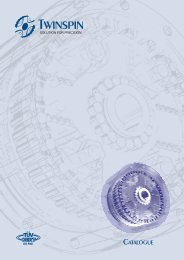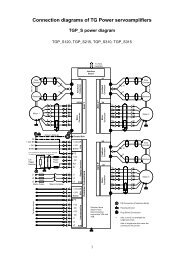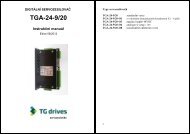Table of Contents - TG Drives
Table of Contents - TG Drives
Table of Contents - TG Drives
Create successful ePaper yourself
Turn your PDF publications into a flip-book with our unique Google optimized e-Paper software.
88<br />
Gear, Electronic gearbox<br />
EXTENDED REGISTER GROUPS<br />
PDATA statements), is set by Gear.CamLen variable. Each PDATA statement<br />
corresponds to 1024 increments.<br />
If there is a 2-pole resolver on RD2 and you want 2 turns on RD2 equal one turn on<br />
the CAM, and 17 PDATA statements are desired.<br />
The PDATA vector length is 17 * 1024 = 17408 increments.<br />
Two turns on RD2 is 8192 * 2 = 16384 increments.<br />
To map 16384 to 17408, the gearbox must be setup like this:<br />
Set Gear.In = 17 and Gear.Out = 16<br />
to accomplish this.<br />
Fill the PDATA statements with the positions for the corresponding index values.<br />
The positions given in the PDATA statements are scaled by the Gear.CamScale,<br />
which has the same function as the PG.ProScale.<br />
In this version, only linear interpolation between index points is possible. The<br />
scaling is disabled when incremental cam is used.<br />
TIME LOCKED CAM<br />
The same as Position Lock cam but RD2 is replaced by a time function to generate<br />
the index into the table.<br />
MASTER/SLAVE<br />
In this mode the gearbox is used to follow a value given by a master. The master<br />
can be as simple as an analog input, in this case a CONNECT command can be<br />
used to connect an analog input to Gear.SlaveSPos. The master can also be<br />
another DMC 2 unit over the LAN, in that case the distributed position can be written<br />
to Gear.SlaveSPos by a user written PL program.<br />
In both cases the Gear.SlaveSPos must be written in a timely manner and the<br />
firmware will automatically calculate the time difference between the writes and<br />
store that value in Gear.SlaveUTime.<br />
The simple interpolation is done internally as,<br />
Gear.<br />
SlavePos − Gear.<br />
SlaveAPos<br />
Gear.<br />
SlaveSpeed =<br />
Tmr.<br />
Abs − Gear.<br />
SlaveUTime<br />
If Gear.SlaveFixTm 0 the calculation will use the fixed value instead.<br />
INCREMENTAL CAM<br />
This mode adds an indexing function to the cam. Each time the index to the cam<br />
table wraps, the Gear.CamInc is added to the output. Gear.CamLen must be set to<br />
the ”number <strong>of</strong> Pdata files minus one”. Gear.CamInc should normally be set to the<br />
last value in the Pdata table. The scaling with Gear.CamScale is disabled in this<br />
mode.<br />
User's Manual 5.1 Inmotion Technologies AB<br />
Doc. No.9032 0027 01 (B), Rev. 11.07.2001

















